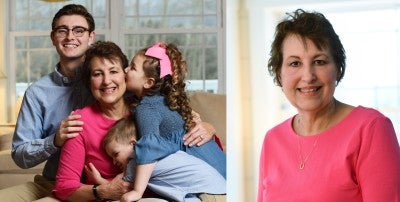
Christine Falvello began feeling fatigued in early December 2016, but she chalked it up to holiday preparations and long hours running her own wealth management business. The following month, though, she was still feeling tired and woke one night to the room spinning.
“I was so nauseous I crawled to the bathroom and then couldn’t find the strength to get back into bed,” says Falvello, who was 65 at the time. After being rushed by ambulance from her home in Drums, Pa., to the emergency room at Lehigh Valley Hospital–Hazleton, a blood test revealed high white blood cell counts and low numbers of clot-forming platelets.
Diagnosing blood disorder
Michael Evans, MD, a hematologist-medical oncologist with LVHN Cancer Center–Hazleton, immediately suspected leukemia, a cancer of the blood and bone marrow. “I went to the lab for a closer look at her blood smear, and it appeared to be acute promyelocytic leukemia (APL), a rare and aggressive form that causes white blood cells to remain immature,” he says. “It’s highly treatable, but there’s danger upfront from a life-threatening blood disorder called disseminated intravascular coagulopathy (DIC), which can cause excessive clotting inside small blood vessels. DIC can lead to severe bleeding in other parts of the body and even death.”
Multiphase care for APL
Lab specialists quickly confirmed Falvello’s APL diagnosis, and she began immediate intravenous (IV) therapy with all-trans-retinoic acid (ATRA) and idarubicin (a chemotherapy drug) as an inpatient. This combination is particularly effective in treating APL, especially if begun immediately. After completing that part of her treatment, Evans recommended that Falvello return home for the two remaining phases as an outpatient at LVHN Cancer Center–Hazleton.
Starting in March 2017, Falvello began receiving IV chemotherapy infusion treatments with ATRA and arsenic trioxide (ATO) at the Hazleton Cancer Center seven days a week. After a month, she dropped to five days a week. Altogether, this second phase of treatment lasted three months and required a grueling daily regimen.
Daily heart and blood checks
Each morning a nurse arrived at Falvello’s home for a blood sample to make sure her immune system was not too compromised to handle infusion that day. Chemotherapy can lead to low blood cell counts and raise infection risk.
Next, Falvello went to the Health & Wellness Center at Hazleton for an electrocardiogram (EKG) to check that her heart rate was normal. Afterward, she headed to the Cancer Center for infusion treatments that lasted from two to six hours, depending on whether she needed a blood transfusion to boost her cell counts.
“I can’t say enough about how caring and kind Cancer Center staff was,” Falvello says. “I was exhausted and struggling to regain my health – I’d lost so much control in my life, including having to give up my business. They understood and did everything they could to make me comfortable. They even let my 1-year-old grandson sit in bed with me. It felt like family.”
Back to health
After some setbacks – including a severe infection that required Falvello to stop infusion treatments for two weeks while receiving IV antibiotics – she is now in remission and undergoing the final “maintenance” phase of her treatment. For the next two years, she will take alternating cycles of oral ATRA and two chemotherapy drugs at home.
Her prognosis is excellent, according to Evans. “Christine has had some balance issues, possibly from one of the medications, but she’s very strong and determined, and is likely to be cured,” he says. “We were able to diagnose her APL quickly and begin treatment right away. Cure rates in these cases are above 90 percent. Best of all, we were able to provide care close to home.”
Falvello agrees. “Dr. Evans diagnosed my condition immediately and saved my life. He was such a steady influence and very caring. I’m so lucky to have that kind of care nearby.”
